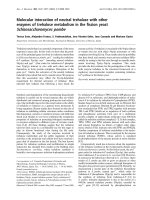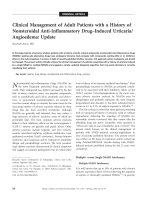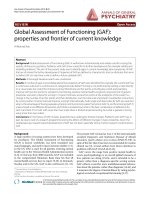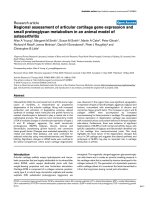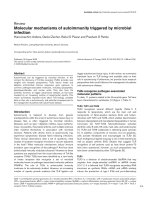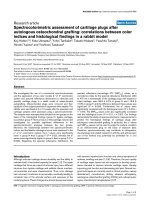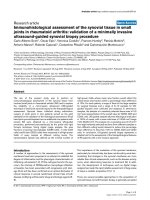Báo cáo y học: "Safety assessment of drotrecogin alfa (activated) in the treatment of adult patients with severe sepsis" pot
Bạn đang xem bản rút gọn của tài liệu. Xem và tải ngay bản đầy đủ của tài liệu tại đây (71.14 KB, 9 trang )
Available online />Research
Safety assessment of drotrecogin alfa (activated) in the
treatment of adult patients with severe sepsis
Gordon R Bernard
1
, William L Macias
2
, David E Joyce
3
, Mark D Williams
3
, Joan Bailey
4
and Jean-Louis Vincent
5
1
Director, Division of Allergy, Pulmonary and Critical Care, Vanderbilt University School of Medicine, Nashville, Tennessee, USA
2
Medical Director, Eli Lilly and Company, Indianapolis, Indiana, USA
3
Clinical Research Physician, Eli Lilly and Company, Indianapolis, Indiana, USA
4
Clinical Research Associate, Eli Lilly and Company, Indianapolis, Indiana, USA
5
Head, Department of Intensive Care, Erasme University Hospital, Brussels, Belgium
Correspondence: Gordon Bernard,
155
APACHE = Acute Physiology and Chornic Health Evaluation; CI = confidence interval; ICH = intracranial hemorrhage.
Abstract
Introduction Drotrecogin alfa (activated; recombinant activated protein C) was shown to reduce 28-
day all-cause mortality in patients with severe sepsis and to have an acceptable safety profile in 1690
patients studied in the F1K-MC-EVAD (PROWESS) trial. We analyzed all available data on the safety
of treatment with drotrecogin alfa (activated) in 2786 adult patients with severe sepsis enrolled in all
phase 2 and 3 clinical trials, and in an estimated 3991 patients receiving the drug in commercial use.
Patients and method Mortality and safety analyses were performed on all available data from adult
severe sepsis patients enrolled in seven clinical trials as of 12 April 2002. Trial-specific safety data and
spontaneously reported serious adverse events from commercial use were extracted from a
pharmacovigilance database.
Results The 28-day mortality rate for all adult patients who received active treatment in all clinical trials
was 25.3% (704/2786). Serious bleeding events during the infusion period and 28-day study period
occurred in 2.8% (79/2786) and 5.3% (148/2786) of patients, respectively. Of bleeding events
during the infusion period, 43% (34/79) were procedure-related. Fatal serious bleeding events during
the infusion period occurred in 0.4% (12/2786) of cases. Intracranial hemorrhage (ICH) events during
the infusion period and 28-day study period occurred in 0.6% (16/2786) and 1.1% (32/2786) of
patients, respectively. Ten out of the 16 ICH events occurring during the study drug infusion period
were associated with severe thrombocytopenia (≤ 30,000/mm
3
) and/or meningitis. Serious bleeding
and ICH events spontaneously reported from commercial use (n = 3991) occurred in 0.9% and 0.2%
of patients, respectively.
Conclusion Drotrecogin alfa (activated) significantly reduces mortality in severe sepsis. The efficacy
and safety profiles of drotrecogin alfa (activated) have remained consistent over the conduct of multiple
clinical trials. The most important serious adverse event associated with drotrecogin alfa (activated)
treatment is bleeding. Additional clinical experience indicates that invasive procedures are associated
with a substantial percentage of serious bleeding events, particularly those occurring at the start of
infusion of the drug. Severe thrombocytopenia (for all serious bleeding events, including ICH) and
meningitis (for ICH only) may be risk factors for serious bleeding. However, patients with severe
thrombocytopenia and/or meningitis may be at greater risk for bleeding or ICH in the absence of drug
therapy.
Keywords activated protein C, drotrecogin alfa (activated), mortality, safety, severe sepsis
Received: 31 October 2002
Revisions requested: 16 December 2002
Revisions received: 8 February 2003
Accepted: 20 February 2003
Published: 28 February 2003
Critical Care 2003, 7:155-163 (DOI 10.1186/cc2167)
This article is online at />© 2003 Bernard et al., licensee BioMed Central Ltd
(Print ISSN 1364-8535; Online ISSN 1466-609X). This is an Open
Access article: verbatim copying and redistribution of this article are
permitted in all media for any purpose, provided this notice is
preserved along with the article's original URL.
Open Access
156
Critical Care April 2003 Vol 7 No 2 Bernard et al.
Introduction
Activated protein C, an endogenous plasma serine protease
with antithrombotic, profibrinolytic and anti-inflammatory
properties [1–3], is an important modulator of the host sys-
temic response to severe infection [1]. Recently, recombinant
human activated protein C (drotrecogin alfa [activated]) was
approved for the treatment of adult patients with severe
sepsis. Regulatory approvals were based on the results of a
single pivotal phase 3 study, which demonstrated a statisti-
cally significantly reduction in 28-day all-cause mortality
(absolute risk reduction compared with placebo 6.1%, rela-
tive risk reduction 19.4%; P = 0.005) [4], with supporting
data from a single phase 2 study [5]. Consistent with its
antithrombotic and profibrinolytic properties, the administra-
tion of drotrecogin alfa (activated), as compared with
placebo, was associated with an increase in the percentage
of patients experiencing a serious bleeding complication
(3.5% versus 2.0%; P = 0.06) over 28 days in the phase 3
study [4]. Bleeding complications were the most important
serious adverse events associated with the administration of
drotrecogin alfa (activated) [4].
A total of 1821 adult patients with severe sepsis were
enrolled in the randomized, placebo-controlled trials support-
ing the approval of drotrecogin alfa (activated); 940 patients
received active treatment and 881 patients received placebo.
Since completion of those controlled trials, further studies
have been completed (n = 2) or are ongoing (n = 3), in which
an additional 1846 patients have received drotrecogin alfa
(activated). Furthermore, up to 12 April 2002, 3991 patients
have received drotrecogin alfa (activated) in commercial use
following approval in the USA.
The purpose of this report is to provide a comprehensive
review of the safety of drotrecogin alfa (activated) for all adult
patients with severe sepsis enrolled in clinical trials (com-
pleted and ongoing) since the start of phase 2 clinical devel-
opment and up to 12 April 2002. Trials were grouped into
three categories: controlled trials, open-label trials, and com-
passionate-use studies. In addition, safety data are presented
for patients who received drotrecogin alfa (activated) from
spontaneous reports in commercial use.
Patients and method
Patient populations
Table 1 lists the seven clinical studies that enrolled adult
patients with severe sepsis and that were completed or
ongoing as of 12 April 2002. Studies were classified as ‘con-
trolled’ if they included a blinded placebo comparison with
drotrecogin alfa (activated; Xigris
, Eli Lilly and Company,
Indianapolis, IN, USA); ‘open-label’ if drotrecogin alfa (acti-
vated) was administered in a single arm study conducted at
prospectively identified and trained investigative sites; or
‘compassionate-use’ if drotrecogin alfa (activated) was pro-
vided on emergent request to noninvestigator clinicians treat-
ing patients with severe sepsis.
All studies, except F1K-MC-EVAS, utilized inclusion and
exclusion criteria similar to those in the phase 3 study F1K-
MC-EVAD (Recombinant Human Activated Protein C World-
wide Evaluation in Severe Sepsis [PROWESS]) [4]. Severe
sepsis was defined in all protocols as the presence of known
or suspected infection, the presence of a systemic response
to infection (as evidenced by alterations in temperature, heart
rate, respiratory rate, and white blood cell count), and the
presence of one or more associated acute organ dysfunc-
tions (cardiovascular, respiratory, renal, hematologic, or meta-
bolic acidemia). Patients excluded from participation included
those at high risk for bleeding, those with severe thrombocy-
topenia (platelet count ≤ 30,000/mm
3
), those taking a variety
of antiplatelet agents, and those receiving systemic heparin
anticoagulation. Study F1K-MC-EVAS required only the clini-
cal diagnosis of purpura fulminans and did not have the pres-
ence of thrombocytopenia as an exclusion criterion.
Table 1
Clinical studies with drotrecogin alfa (activated) in adult patients with severe sepsis
Study ID Study descriptor Dosage and administration Status
F1K-MC-EVAA (n = 90) A phase 2 dose-ranging study 12, 18, 24, 30 µg/kg per hour for 48 hours; Completed
12, 18, 24 µg/kg per hour for 96 hours
F1K-MC-EVAD (n = 850) A phase 3 efficacy study (PROWESS) 24 µg/kg per hour for 96 hours (±1 hour). Completed
F1K-MC-EVAS (n = 28) A compassionate-use study in 24 µg/kg per hour for a minimum of 96 hours Completed
purpura fulminans
F1K-MC-EVBE (n = 273) An open-label study (ENHANCE) 24 µg/kg per hour for 96 hours (±1 hour) Completed
F1K-MC-EVBF (n = 1189) An open-label study (ENHANCE) 24 µg/kg per hour for 96 hours (±1 hour) Ongoing
F1K-MC-EVBG (n = 116) An open-label study (ENHANCE) 24 µg/kg per hour for 96 hours (±1 hour) Ongoing
F1K-MC-EVBC (n = 240)
1
A compassionate-use study 24 µg/kg per hour for 96 hours (±1 hour) Ongoing
Source: clinical study reports for completed studies and protocols for ongoing studies.
1
Mortality and safety monitored for 7 days in countries
outside the USA. PROWESS, Recombinant Human Activated Protein C Worldwide Evaluation in Severe Sepsis; ENHANCE, Extended Evaluation
of Recombinant Human Activated Protein C.
157
Based on the approved recommendations for the USA,
patients receiving drotrecogin alfa (activated) in commercial
use would have been expected to have severe sepsis and
have been at high risk for death (e.g. as assessed using the
Acute Physiology and Chronic Health Evaluation [APACHE]
II) [6]. The number of patients who received drotrecogin alfa
(activated) in commercial use was estimated from the total
number of courses of therapy sold in the USA using hospital-
based stores information from 21 November 2001 until 12
April 2002.
Drug administration
Table 1 lists details of drug dose and durations of infusion for
each clinical trial. Patients randomly assigned to placebo in
the controlled clinical trials received either saline or 0.1%
albumin in saline. Based on the approved recommendations
for the USA [6], patients receiving drotrecogin alfa (activated)
in commercial use would have been expected to receive an
infusion rate of 24 µg/kg per hour for a total duration of
96 hours. Specific details regarding actual dose and duration
of administration were not available for patients treated in
commercial use.
Estimates of 28-day mortality rate
Mortality rates for completed clinical trials were obtained from
validated clinical trial databases. Estimates of 28-day all-cause
mortality rates for ongoing clinical studies were obtained from
separate trial-specific databases created using trial-specific
tracking tools. Twenty-eight-day all-cause mortality (i.e. 28
days after the start of infusion) was assessed for all studies,
except study F1K-MC-EVBC, in which 7-day mortality was
assessed for a subset of patients (non-US). For this subset,
the number of additional deaths occurring between days 7
and 28 was estimated using the following method. Of the 240
adults in study F1K-MC-EVBC, 28-day follow-up data were
available for 168 patients (40 deaths) and 7-day follow up
data were available for 72 patients (12 deaths). It was deter-
mined from the result of F1K-MC-EVAD (PROWESS) that the
28-day mortality rate in 7-day survivors receiving drotrecogin
alfa (activated) was 15.2%. Therefore, for the subset of 7-day
survivors in study F1K-MC-EVBC, an additional nine deaths
(15.2% of 60) were estimated to have occurred before study
day 28. Thus, total 28-day mortality in study F1K-MC-EVBC
was estimated at (12 + 9 + 40)/240 = 0.254.
At present, an estimate of the mortality rate for patients who
have received drotrecogin alfa (activated) in commercial use is
not available. For the placebo-controlled studies (F1K-MC-
EVAA and F1K-MC-EVAD [PROWESS]), the cause of death
was adjudicated by Lilly physicians, in a blinded manner, for all
patients from death summaries provided by the investigators.
Serious bleeding event rate estimates
Bleeding complications meeting the regulatory definition of a
serious adverse event were extracted from a validated phar-
macovigilance database, which included events reported in
clinical trials and in commercial use. For all clinical trials in
this report, bleeding complications included, but were not
limited to, any of the following: any intracranial hemorrhage
(ICH); any life-threatening bleeding event; requirement for
3 units or more of packed red blood cell transfusion per day
for 2 consecutive days; or meeting other criteria defining
serious adverse events. For patients experiencing ICH, the
following data were extracted from the serious adverse event
report: type of ICH; most recent platelet count; and presence
of meningitis.
The causal relationship of drotrecogin alfa (activated) to
serious bleeding events was assessed by comparison with
placebo event rates for controlled trials. For open-label and
compassionate-use studies, causal relationship was
assessed using investigator assignment of causality (related
or not related) and by comparing events that occurred during
the infusion period with events that occurred postinfusion.
The study drug infusion period was defined as the actual
duration of infusion plus 1 calendar day (study days 1–5).
The ‘postinfusion period’ was defined as study days 6–28. All
serious bleeding events were assessed as ‘procedure-
related’ (if associated with an invasive procedure) or ‘non-pro-
cedure-related’.
Serious bleeding events were recorded for up to 28 days fol-
lowing the start of study drug administration for all but one
study (F1K-MC-EVBC). In study F1K-MC-EVBC, serious
bleeding events were recorded for up to 28 days, except for
a subset of patients (n = 72). For this subset, all serious
bleeding events were recorded for 7 days following the start
of infusion and study drug-related serious bleeding events
were recorded for up to 28 days.
Statistical analysis
Because of the lack of final, validated baseline data for
ongoing clinical trials, comparisons between clinical trial
types were avoided. Accordingly, 95% confidence intervals
(CIs) using exact methods are reported for event rate esti-
mates. Hypothesis testing was not performed as part of the
present study. All calculations were performed using SAS
version 8.2 software (SAS Institute, Inc., Cary, NC, USA).
Results
Twenty-eight-day all-cause mortality
The administration of drotrecogin alfa (activated) was associ-
ated with a mortality rate in controlled trials of 25.1%
(236/940; 95% CI 22.4–28.0%), in open-label studies of
25.2% (398/1578; 95% CI 23.1–27.4%), and in compas-
sionate-use studies of 26.1% (70/268; 95% CI
21.0–31.8%). The mortality rate for all patients treated with
drotrecogin alfa (activated) in clinical trials was 25.3%
(704/2786; 95% CI 23.7–26.9%). The point estimate of the
mortality rate with drotrecogin alfa (activated) for each trial
category was less than the combined placebo mortality rate
of 31.0% (273/881; 95% CI 28.0–34.2%). An estimate of
Available online />158
the mortality rate for the population of patients who received
drotrecogin alfa (activated) in commercial use is not available.
In controlled clinical trials, the leading causes of death were
multiple organ failure, refractory septic shock, and respiratory
failure (Table 2). There were numerically fewer deaths from
refractory septic shock and respiratory failure in drotrecogin
alfa (activated) treated patients than in placebo treated
patients. There were fewer deaths from ICH and stroke com-
bined in drotrecogin alfa (activated) treated patients than in
placebo treated patients in controlled trials (Table 2).
Serious bleeding events
The overall rate of serious bleeding events for all patients
treated with drotrecogin alfa (activated) in all clinical trials
combined was 5.3% (148/2786) over the 28-day study
period. The serious bleeding event rate associated with
drotrecogin alfa (activated) was similar across classes of
trials (controlled, open-label, and compassionate-use;
Table 3).
The majority of serious bleeding events (58/79) that occurred
during the infusion period in patients in all clinical trials
(2.1%; 58/2786) were considered by the investigator to be
related to drotrecogin alfa (activated). When assessed,
thrombocytopenia (platelet counts ≤ 50,000/mm
3
) was fre-
quently present in drotrecogin alfa (activated) treated patients
who experienced a serious bleeding event during the infusion
period (22/53 patients for whom data were available;
Table 4). Twenty-one serious bleeding events, which
occurred during the infusion period (0.8% of all patients;
21/2786), were not considered to be related to drotrecogin
alfa (activated). This incidence rate (0.8%) was similar to the
serious bleeding event rate observed during the infusion
period for placebo treated patients in controlled studies
(0.7%; 6/881). In F1K-MC-EVAD (PROWESS), the inci-
dence of serious bleeding events during the postinfusion
period was similar between drotrecogin alfa (activated)
(12/850) and placebo patients (11/840; both approximately
1%). For all drotrecogin alfa (activated) treated patients, only
a small minority of serious bleeding events that occurred
during the postinfusion period (8/69 events; 0.3% of all
patients) were considered to be related to drotrecogin alfa
(activated).
A relatively high proportion of all serious bleeding events was
found to be related to invasive procedures, as shown in
Table 5. In the phase 3 trial (study F1K-MC-EVAD
[PROWESS]), 53.3% (16/30) of serious bleeding events in
drotrecogin alfa (activated) treated patients and 23.5%
(4/17) in placebo treated patients were associated with inva-
sive procedures during the 28-day study period. These pro-
cedures typically involved the instrumentation of large blood
vessels or highly vascular organs. The incidence of non-pro-
Critical Care April 2003 Vol 7 No 2 Bernard et al.
Table 2
Summary of causes of death in placebo-controlled clinical
trials
1
Drotrecogin
alfa Placebo
Cause of death category (activated; n [%]) (n [%])
Sepsis-induced multiorgan failure 113 (47.9) 107 (39.2)
Refractory septic shock 49 (20.8) 65 (23.8)
Respiratory failure 32 (13.6) 51 (18.7)
Myocardial infarction 9 (3.8) 11 (4.0)
Primary cardiac arrhythmia 6 (2.5) 9 (3.3)
Hemorrhage 4 (1.7) 1 (0.4)
Intracranial hemorrhage 2 (0.8) 1 (0.4)
Stroke 2 (0.8) 7 (2.6)
Other 19 (8.1) 21 (7.7)
Total deaths 236 (100) 273 (100)
The drotrecogin alfa (activated) groups comprised 940 and the
placebo groups 881, yielding a total of 1821 patients.
1
F1K-MC-EVAA
and F1K-MC-EVAD (PROWESS).
Table 3
Rates of serious bleeding events classified as during the infusion period and postinfusion period in all clinical trials
SBE during infusion period SBE postinfusion period
Population Patients (n) % (95% CI) Patients (n) % (95% CI)
Placebo (n = 881) 6 0.7 (0.3–1.5) 14 1.6 (0.8–2.7)
Drotrecogin alfa (activated)
All controlled trials (n = 940) 20 2.0 (1.3–3.3) 15 1.6 (0.9–2.6)
All open-label studies (n = 1578) 49 3.1 (2.3–4.1) 45 2.9 (2.1–3.8)
All compassionate-use studies (n = 268) 10 3.7 (1.8–6.8) 9 3.4 (1.6–6.3)
All treated patients (n = 2786) 79 2.8 (2.3–3.5) 69 2.5 (1.9–3.1)
CI, confidence interval; SBE, serious bleeding event.
159
cedure-related serious bleeding events (i.e. spontaneous
bleeding events) was similar between active treatment and
placebo groups in that trial. In all patients receiving drotreco-
gin alfa (activated) in clinical trials, serious bleeding events
associated with invasive procedures accounted for 39.2%
(58/148) of the total number of events (Table 5).
The incidence of serious bleeding events was highest during
the first day of therapy and decreased thereafter for all
drotrecogin alfa (activated) treated patients. Of serious
bleeding events on day 1 of therapy, 56% (15/27) were pro-
cedure-related. On day 1 there were 12 patients with non-
procedure-related serious bleeding events. Platelet counts
were not available for three of these 12 patients. Of the
remaining nine patients, three had severe thrombocytopenia
(platelets ≤ 30,000/mm
3
) and three had an elevated interna-
tional normalized ratio greater than 2.0.
In commercial use, 3991 patients received treatment with
drotrecogin alfa (activated) in the USA. There have been 34
serious bleeding events spontaneously reported to the phar-
macovigilance database, for a rate of 0.9% (34/3991). If one
assumes that many of those patients had APACHE II scores
greater than 25, then comparison with PROWESS (F1K-MC-
EVAD) patients who had APACHE II scores greater than 25
is possible. PROWESS (F1K-MC-EVAD) patients with
APACHE II scores greater than or equal to 25, who received
drotrecogin alfa (activated) and suffered serious bleeding
events during the infusion period, amounted to 9/414 (2.2%)
and those with scores below 25 amounted to 9/436 (2.1%).
In PROWESS (F1K-MC-EVAD), 75% (634/850) of patients
who received drotrecogin alfa (activated) and a similar per-
centage (76%; 637/840) of patients who received placebo
were exposed to heparin during the infusion period.
PROWESS (F1K-MC-EVAD) patients who had serious
bleeding events during the infusion period and were exposed
to heparin amounted to 11/18 (61.1%). For comparison,
14/49 (28.6%) of patients in open-label trials and 3/10
(30.0%) patients in compassionate-use trials who had
Available online />Table 4
Classification by platelet counts of all serious bleeding events
during infusion period in all clinical trials
SBEs during infusion period
Platelets (×10
3
/mm
3
)
1
Events (n) Cumulative %
≤ 20 5 9.4
> 20 to ≤ 30 6 20.8
> 30 to ≤ 50 11 41.5
> 50 to ≤100 12 64.2
>100 19 100.0
Not available 26
Total 79
A total of 2786 patients treated with drotrecogin alfa (activated)
infusion were included in this analysis.
1
Platelet counts were recorded
within the preceding 24 hours of a serious bleeding event (SBE).
Table 5
Number of procedure-related 28-day serious bleeding events by site of hemorrhage sorted from largest to smallest percentage of
serious bleeding events that were procedure-related in all clinical trials
Procedure-related events
Site of hemorrhage During infusion period Postinfusion period Total procedure-related All SBEs
1
% Procedure-related
Vascular 5 2 7 7 100.0
Retroperitoneal 2 1 3 3 100.0
Intra-abdominal 5 4 9 10 90.0
Skin/soft tissue 9 3 12 15 80.0
Intrathoracic 8 3 11 20 55.0
Other/undetermined 2 5 7 14 50.0
Spleen 0 1 1 3 33.3
Gastrointestinal 3 5 8 44 18.2
ICH 0 0 0 32 0.0
Total 34 24 58 148 39.2%
A total of 2786 patients treated with drotrecogin alfa (activated) infusion were included in this analysis.
1
All serious bleeding events (SBEs)
combines both procedure-related and non-procedure-related events during the 28-day period. ICH, intracerebral hemorrhage.
160
serious bleeding events during the infusion period were
exposed to heparin.
Serious bleeding events – intracranial hemorrhage
subset
In controlled clinical trials, two patients receiving drotrecogin
alfa (activated; 0.2%; 2/940) and one patient receiving
placebo (0.1%; 1/881) experienced ICH (all reported as
parenchymal). Both events in the drotrecogin alfa (activated)
group occurred during the study drug infusion period and
were associated with severe thrombocytopenia (platelet
count ≤ 30,000/mm
3
). All three events were associated with a
fatal outcome. In open-label studies, 11 and 10 patients
receiving drotrecogin alfa (activated) experienced ICH during
the infusion period (0.7%) and postinfusion period (0.6%),
respectively. Three and six patients receiving drotrecogin alfa
(activated) in compassionate-use studies experienced ICH
during the infusion period (1.1%) and postinfusion period
(2.2%), respectively.
For all patients receiving drotrecogin alfa (activated) in clinical
trials, the ICH rate was 0.6% (16/2786) during the study
drug infusion period and 0.6% (16/2786) during the postinfu-
sion period. The overall 28-day ICH event rate was 1.1%
(32/2786).
Parenchymal hemorrhage (n = 14) was the most common
site of ICH event during the infusion period (Table 6). Nine
ICH events that occurred during the infusion period were
fatal, of which seven were considered related to drotrecogin
alfa (activated) (Table 7). Five of these seven events, which
were considered to be related to drotrecogin alfa (activated),
were associated with thrombocytopenia (platelets
≤ 50,000/mm
3
; range 17,000–49,000/mm
3
). Meningitis was
present in two of those five events, and severe thrombo-
cytopenia (platelets ≤ 30,000/mm
3
) was present in four of
those five events. Ten of the 16 events (62.5%) had one or
both potential risk factors (Table 8). Eight fatal ICH events
occurred during the postinfusion period, of which only one
was considered related to drotrecogin alfa (activated). The
other seven fatal ICH events considered not related to
drotrecogin alfa (activated) occurred between study days 8
and 28 – well after the infusion period.
In commercial use, 0.2% (8/3991) patients receiving
drotrecogin alfa (activated) were reported to have experi-
enced an ICH.
Non-ICH serious bleeding events associated with fatal
outcome
In controlled clinical trials, four drotrecogin alfa (activated)
patients and one placebo patient experienced non-ICH
serious bleeding events associated with a fatal outcome
based on adjudicated cause of death. Fatal non-ICH serious
bleeding events that were reported as serious adverse events
for drotrecogin alfa (activated) patients in all clinical trials
combined are presented in Table 8. Three patients experi-
enced non-ICH serious bleeding events associated with a
fatal outcome. All three events occurred during the infusion
period and all were considered related to drotrecogin alfa
(activated). One of these involved thrombocytopenia
(platelets 19,000/mm
3
) with severe coagulopathy (partial
thromboplastin time ≥150 s).
Discussion
The observed mortality rates for patients receiving drotreco-
gin alfa (activated) were consistent across controlled, open-
label and compassionate-use trials, ranging from 25.1% to
26.1%. These results are similar to, and supportive of, the
observed mortality rate of 24.7% associated with drotrecogin
alfa (activated) use reported in the pivotal, phase 3 trial
F1K-MC-EVAD (PROWESS) [4]. These mortality rates are
lower than recent mortality rate estimates for severe sepsis,
which ranged between 30% and 50% [7] and lower than the
combined placebo rate from controlled clinical trials of
31.0%. The consistency of treatment effects in drotrecogin
Critical Care April 2003 Vol 7 No 2 Bernard et al.
Table 6
Intracranial hemorrhages classified according to type during infusion period, postinfusion period, and for the total 28 days after
initiation of infusion in all clinical trials
Intracranial hemorrhage type During infusion period During postinfusion period Total
Parenchymal
1
14 6 20
Subarachnoid 1 1 2
Subdural 0 1 1
Other/undetermined 1 1 2
Stroke with hemorrhagic transformation 0 7 7
Total 16 16 32
A total of 2786 patients treated with drotrecogin alfa (activated) infusion were included in this analysis.
1
Spontaneously occurring parenchymal
hemorrhage.
161
alfa (activated) patients might have been expected given that,
for the most part, inclusion and exclusion criteria were similar
across trials.
The survival benefit associated with drotrecogin alfa (acti-
vated) appears to be related to a reduction in the number of
deaths from refractory septic shock and respiratory failure.
These observations are consistent with the observed more
rapid improvement in cardiovascular and respiratory function
for drotrecogin alfa (activated) patients as compared with
placebo patients in study F1K-MC-EVAD (PROWESS) [8].
Consistent with its antithrombotic and profibrinolytic proper-
ties, drotrecogin alfa (activated) increased the risk for serious
bleeding. The overall serious bleeding event rate (5.3%)
includes compassionate-use trials, in which investigators had
limited experience using drotrecogin alfa (activated). The per-
centage of patients experiencing an event probably related to
drotrecogin alfa (activated) appears to range between 2.1%
and 2.8%, as assessed by the investigator or by whether the
event occurred during the infusion period, respectively.
Approximately 2.0% of placebo patients enrolled in controlled
trials experienced a serious bleeding event over the 28-day
period. Neither APACHE II score (< 25 or ≥ 25) nor concomi-
tant heparin use appear to alter serious bleeding event rates
associated with drotrecogin alfa (activated) substantially.
Underreporting of baseline heparin exposure in the open-
label and compassionate-use trials is likely, given that med-
ication listings for the safety database were only collected on
the day of the event.
Serious bleeding event rates for both active treatment and
placebo patients enrolled in clinical trials of drotrecogin alfa
(activated) probably underestimate the bleeding risk for all
patients with severe sepsis. In these trials, patients at
increased risk for bleeding (e.g. some patients with multiple
trauma) or patients with severe thrombocytopenia (i.e. platelet
count ≤ 30,000/mm
3
) were excluded from participation. Clini-
cal trials of treatment of severe sepsis with other novel thera-
peutics that have antithrombotic properties also excluded a
similar patient population. Estimates of serious bleeding com-
plications in these latter trials ranged between 6.0% [9] and
12.8% [10] for placebo treated patients. Exclusion criteria
related to bleeding risk similar to those used in all of these
trials should be employed in developing guidelines for the use
of drotrecogin alfa (activated).
Available online />Table 7
Summary of all fatal bleeding events related and unrelated to drotrecogin alfa (activated) in all clinical trials
During infusion period Post-infusion period
Type of event Drug related (n [%]) Not related (n [%]) Drug related (n [%]) Not related (n [%])
All ICH bleeding 12 (0.4) 4 (0.1) 6 (0.2) 10 (0.4)
Fatal ICH bleeding 7 (0.3) 2 (0.07) 1 (0.04) 7 (0.3)
Fatal non-ICH bleeding 3 (0.1) 0 (0) 0 (0) 0 (0)
A total of 2786 patients treated with drotrecogin alfa (activated) infusion were included in this analysis. ICH, intracranial hemorrhage.
Table 8
Classification by platelet counts of intracranial hemorrhages during infusion period and cross-classification with presence of
meningitis in all clinical trials
ICH during infusion period
Platelets (×10
3
/mm
3
)
1
Events
2
Cumulative % of patients Meningitis
≤20 3/5 20.0% (3/15) 1/3
>20 to ≤30 3/6 40.0% (6/15) 1/3
>30 to ≤50 2/11 53.3% (8/15) 0/2
>50 to ≤100 3/12 73.3% (11/15) 2/3
>100 4/19 100.0% (15/15) 2/4
Not available 1/26
Total 16/79 6/16
A total of 2786 patients treated with drotrecogin alfa (activated) infusion were included in this analysis.
1
Platelet counts were recorded within the
preceding 24 hours of an intracerebral hemorrhage (ICH).
2
Patients with an ICH/all patients with a serious bleeding event.
162
Severe thrombocytopenia is included as a ‘warning’ in the US
Package Insert and as a ‘contraindication’ in the European
Summary of Product Characteristics. In the former instance,
the recommendation is for physicians to weigh potential
benefit of drotrecogin alfa (activated) against a potentially
increased risk associated with its use. In the European
Summary of Product Characteristics, the recommendation is
that physicians not administer drotrecogin alfa (activated) to
patients with platelet counts of 30,000/mm
3
or less. Indeed,
serious bleeding events in drotrecogin alfa (activated)
patients appear to be associated with severe thrombocytope-
nia, suggesting that this characteristic may be a risk factor for
bleeding complications. Therefore, maintaining a platelet
count above 30,000/mm
3
and discontinuing the drotrecogin
alfa (activated) infusion if the platelet count falls below this
level are reasonable recommendations to guide its use.
A large percentage of bleeding events associated with
drotrecogin alfa (activated) were also related to procedures
performed either before or during the infusion period. The
types of procedures associated with bleeding complications
were frequently those in which adequate control of bleeding
vessels could not be obtained. In controlled trials, the per-
centage of patients experiencing non-procedure-related
bleeding complications was similar between drotrecogin alfa
(activated) and placebo patients. Therefore, limiting invasive
procedures before and during infusion of drotrecogin alfa
(activated), as well as minimizing risks associated with proce-
dures (e.g. instrumentation of blood vessels in which direct
compression might be expected to control bleeding), could
improve the safety profile of the drug.
Additionally, approved product labels recommend stopping
the drotrecogin alfa (activated) infusion 2 hours before inva-
sive procedures and waiting 12 hours after major surgical
procedures to restart the infusion after ensuring adequate
hemostasis [6]. The infusion may be restarted immediately
after uncomplicated, less invasive procedures after ensuring
adequate hemostasis. These recommendations are based on
the observation that the concentration of drotrecogin alfa
(activated) in plasma is below the assay level of detection in a
large majority of patients within 2 hours of discontinuing the
infusion [11].
The difference between ICH events occurring during the infu-
sion period (0.6%) or considered related to drug, and the ICH
event rate in all clinical trials combined (1.1%) was similar to
the background rate for ICH reported for patients with severe
sepsis. In a recent large sepsis trial of antithrombin III, 0.4% of
placebo treated patients experienced ICH during the study
[10]. Oppenheim-Eden et al. [12] also reported an ICH event
rate of 0.4% for all intensive care unit patients who did not
have an admitting diagnosis of stroke or stroke syndrome.
However, all patients experiencing ICH had a diagnosis of
severe sepsis and a platelet count of 30,000/mm
3
or less,
suggesting that the event rate for the severe sepsis population
overall may exceed 0.4% [12]. In a recently completed phase
2 trial of platelet activating factor-ase, an ICH event rate of
2.3% (1/43) was reported in placebo-treated sepsis patients
(Opal S, personal communication).
Approximately 0.4% of drotrecogin alfa (activated) patients
experienced a serious bleeding event associated with a fatal
outcome that was considered related to its use during the
infusion period. These events were most frequently ICH
events. These data suggest that, although use of drotrecogin
alfa (activated) reduces sepsis-induced mortality, its anti-
coagulant effects may increase the risk for life-threatening
bleeding complications. Patients that appear to be at risk for
such a complication are those with severe coagulopathy (i.e.
low platelet counts, high international normalized ratio). Risk
for sepsis-related death in these patients may be greater than
that in the overall population of severe sepsis patients with no
coagulopathy.
In controlled trials, although drotrecogin alfa (activated)
treated patients experienced more hemorrhage-related deaths,
there were fewer deaths from stroke in drotrecogin alfa (acti-
vated) patients than in placebo patients (two versus seven
patients). The composite end-point of any fatal ICH and any
fatal stroke favored drotrecogin alfa (activated) as compared
with placebo (four versus eight patients). The number of
patients experiencing any fatal bleeding event or any fatal
stroke was similar between the drotrecogin alfa (activated)
and placebo groups (nine versus eight patients, respectively).
These data suggest that the 28-day all-cause mortality rates
reported for drotrecogin alfa (activated) represent a composite
end-point of less sepsis-induced death, potentially less throm-
botic-related deaths, as well as any fatal complications associ-
ated with the use of drotrecogin alfa (activated).
The primary limitation of these analyses was the lack of
placebo treatment groups for five of the seven studies
reported, and no comparison group for patients administered
drotrecogin alfa (activated) under commercial use. Addition-
ally, baseline data describing the patient population was
unavailable for patients enrolled in ongoing trials or receiving
drotrecogin alfa (activated) commercially. There were also
notable differences in the inclusion criteria used to enroll
patients in the compassionate-use study F1K-MC-EVAS (i.e.
that study enrolled only patients with purpura fulminans). This
inclusion criterion may explain, in part, the higher bleeding
rates seen in compassionate-use trials.
Conclusion
Drotrecogin alfa (activated) significantly reduces mortality in
severe sepsis. The treatment efficacy and safety profiles of
drotrecogin alfa (activated) have remained consistent over
multiple clinical trials. The only significant serious adverse
event associated with drotrecogin alfa (activated) treatment is
bleeding. Additional clinical experience indicates that invasive
procedures are associated with a substantial percentage of
Critical Care April 2003 Vol 7 No 2 Bernard et al.
163
these serious bleeding events. Severe thrombocytopenia (for
all serious bleeding events) and meningitis (for ICH only) may
be risk factors for serious bleeding. Mitigating the risk for
serious bleeding by maintaining adequate platelets (e.g.
> 30,000/mm
3
) during drotrecogin alfa (activated) infusion
may reduce risk for both bleeding and ICH.
Competing interests
Gordon R Bernard received grant support from Eli Lilly and
Company and serves as an occasional consultant; Jean-Louis
Vincent is a consultant to Eli Lilly and Company; and William
L Macias, David E Joyce, Mark D Williams, and Joan Bailey
are employees of Eli Lilly and Company.
Acknowledgements
The authors are very grateful to the clinical staff at the Vanderbilt Coor-
dinating Center; to all of the investigators, study coordinators, and
pharmacists who participated in the clinical trials reported; and to the
product development team at Eli Lilly and Company. We thank David R
Nelson for his expert statistical assistance in compiling the analyses in
this report and Gerald Johnson III, PhD, for his expert review and com-
mentary on the manuscript. We thank Cheryl Smith and Cees Schep
for provision of data from Pharmacovigilance. We also wish to thank Eli
Lilly and Company for their financial support.
References
1. Esmon CT: The protein C anticoagulant pathway. Arterioscler
Thromb 1992, 12:135-145.
2. Walker FJ, Sexton PW, Esmon CT: The inhibition of blood coagu-
lation by activated protein C through the selective inactivation
of activated factor V. Biochim Biophys Acta 1979, 571:333-342.
3. Fulcher CA, Gardiner JE, Griffin JH, Zimmerman TS: Proteolytic
inactivation of human factor VIII procoagulant protein by acti-
vated human protein C and its analogy with factor V
[abstract]. Blood 1984, 63:486-489.
4. Bernard GR, Vincent J-L, Laterre P-F, LaRosa SP, Dhainaut J-F,
Lopez-Rodriguez A, Steingrub JS, Garber GE, Helterbrand JD, Ely
EW, Fisher CJ: The Recombinant Human Activated Protein C
Worldwide Evaluation in Severe Sepsis (PROWESS) Study
Group, Efficacy and safety of recombinant human activated
protein C for severe sepsis. N Engl J Med 2001, 344:699-709.
5. Bernard GR, Ely EW, Wright TJ, Fraiz J, Stasek JE, Russell JA,
Mayers I, Rosenfeld BA, Morris PE, Yan BS, Helterbrand JD, on
behalf of the rhAPC Sepsis Study Group: Safety and dose rela-
tionship of recombinant human activated protein C for coagu-
lopathy in severe sepsis. Crit Care Med 2001, 29:2051-2059.
6. Eli Lilly and Company: Xigris
TM
[package insert]. Indianapolis, IN:
Eli Lilly and Company; 2001.
7. Angus DC, Linde-Zwirble WT, Lidicker J, Clermont G, Carcillo J,
Pinsky MR: Epidemiology of severe sepsis in the United
States: analysis of incidence, outcome, and associated costs
of care. Crit Care Med 2001, 29:1303-1310.
8. Vincent J-L, Angus DC, Artigas A, Kalil A, Basson B, Jamal HH,
Johnson G III, Bernard GR, for the Recombinant Human Activated
Protein C Worldwide Evaluation of Severe Sepsis (PROWESS)
Study Group: Effects of drotrecogin alfa (activated) on organ
dysfunction in the PROWESS trial. Crit Care Med 2003:in
press.
9. Abraham W, Reinhart K, Svoboda P, Selbert A, Olthoff D, Nogare
AD, Postier R, Hempelmann G, Butler T, Martin E, Zwingelstein C,
Percell S, Shu V, Leighton A, Creasey AA: Assessment of the
safety of recombinant tissue factor pathway inhibitor in
patients with severe sepsis: a multicenter, randomized,
placebo-controlled, single-blind, does escalation study. Crit
Care Med 2001, 29:2081-2089.
10. Warren BL, Eid A, Singer P, Pillay SS, Carl P, Novak I, Chalupa P,
Atherstone A, Penzes I, Kubler A, Knaub S, Keinecke HO, Hein-
richs H, Schindel F, Juers M, Bone RC, Opal SM, KyberSept Trial
Study Group: Caring for the critically ill patient. High-dose
antithrombin III in severe sepsis: a randomized controlled
trial. JAMA 2001, 286:1869-1878.
11. Macias WL, Dhainaut J-F, Yan SB, Helterbrand JD, Seger M,
Johnson G III, Small DS: Pharmacokinetic-pharmacodynamic
analysis of drotrecogin alfa (activated) in patients with severe
sepsis. Clin Pharmacol Ther 2002, 72:391-402.
12. Oppenheim-Eden A, Glantz L, Eidelman LA, Sprung CL: Sponta-
neous intracerebral hemorrhage in critically ill patients: inci-
dence over six years and associated factors. Intensive Care
Med 1999, 25:63-67.
Available online />Key messages
• Mortality rates in drotrecogin alfa (activated) treated
patients remained consistent across trials
• The most important serious adverse event associated
with drotrecogin alfa (activated) treatment is bleeding
• Serious bleeding events are most frequent on day 1 of
therapy with drotrecogin alfa (activated) and rapidly
decline on subsequent days
• Serious bleeding events were frequently procedure-
associated
• ICH during infusion period of drotrecogin alfa (acti-
vated) was frequently associated with severe thrombo-
cytopenia and/or meningitis

